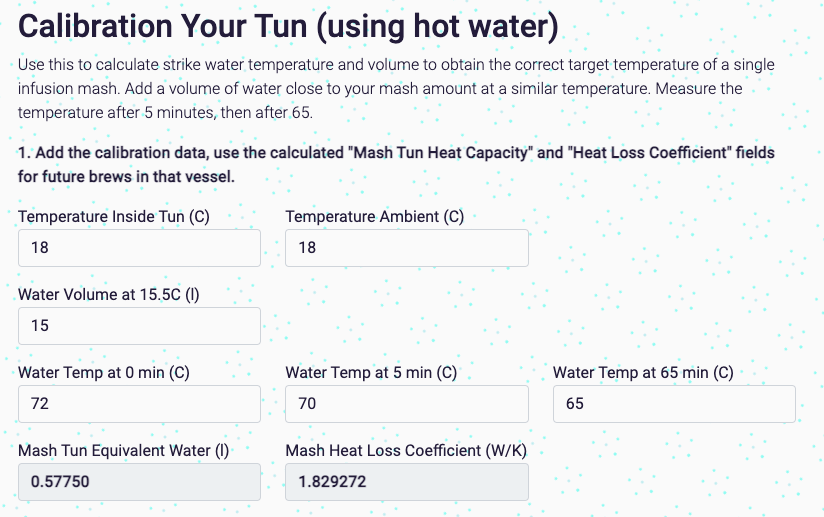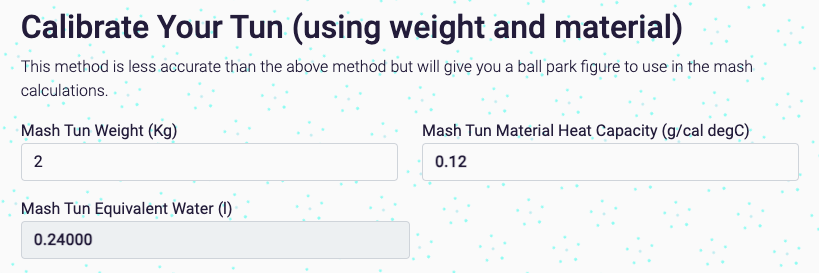Mash Tun Calibrate
Mash tun heat capacity.
Calibrating here involves working out how much heat your mash tun absorbs. The purpose of this is to work out how hot your water needs to be to achieve the correct mash temperature. If your mash tun is unheated (e.g. picnic cooler style), this is a crucial calculation to perform. If you have a heated mash tun (e.g. Grainfather style all in one vessel), you're unlikely to need this calculator.
You'll need to take the tun equivalent water figure and use that in the strike temperature calculator.

Here we're trying to calculate 2 important figures:
- Mash Tun Equivalent Water (l): how much heat your mash tun absorbs. The equivalent in litres of water. Used to calculate strike temperature.
- Mash Heat Loss Coefficient (W/K): how much heat your mash tun loses. Used to calculate your mash end temperature.
Note: these features aren't built into the recipe page yet.
Typically, you'll set aside a few hours and simply do this with some hot water in your tun. Follow this procedure:
- Measure and record Temperature inside Tun and Temperature Ambient.
- Measure at least half the capacity of your mash tun tapwater (at around 15C), heat it up to approximately mash temperature. Not the cool volume of this water (Water Volume at 15.5C (l)), and the temperature when you add it to the mash tun (Water Temp at 0 min).
- Set a timer.
- Measure the temperature after 5 minutes (enter this into the calculator - Water Temp at 5 min). This will give you the correct Tun Equivalent Water figure. Stop here if you don't want to know the Heat Loss Coefficient.
- Measure the temperature after 65 minutes (enter this into the calculator - Water Temp at 65 min). This will give you the Heat Loss Coefficient.

This is a really simple (if less accurate) method of working out your Tun Equivalent Water.
Materials absorb different amounts of heat energy. A kg of plastic can absorb more heat than a kg of stainless steel. The figure we use to determine this is known as Specific Heat Capacity.
Typically, we estimate the specific heat capacity with the following figures:
- Stainless Steel: 0.12 g/cal deg C
- Plastic: 0.35 g/cal deg C
If you know the weight of your tun (look in the manufacturers specifications) and the material, you have a ballpark idea of the Tun Equivalent Water, which is used to calculate strike temperature and mash end temperature.
Inaccuracies
I'd always recommend the Hot Water Method (first calculator on the page) as this is real, experimental data. This will work at a push, but there are going to be inconsistencies due to:
- Mash tun vessels aren't always 100% plastic, or 100% metal. e.g. there may be metal in plastic like a false bottom.
- The vessels aren't solid lumps of material - they have spaces, air pockets etc which won't absorb the energy as quickly and don't effect your strike temperature. Consider the outside wall of a picnic basket, if it doesn't feel warm after 5 minutes, then that outer section shouldn't really be contributing towards the equivalent water.
todo
- [ ] Save tun equivalent water to user profile.
- [ ] Heat Loss Coefficient - I can't see this used in either the Strike Temp or Step Mash calculators. What's it for? Figuring out how the mash tun holds it's temp, ok, but it's not used in any calcs I have.
- [ ] Multiple choice - or at least some options for materials?
James Torr 18 Jun 22